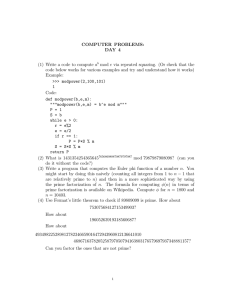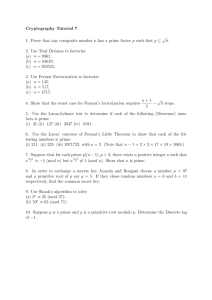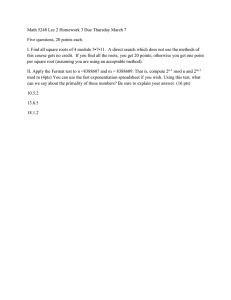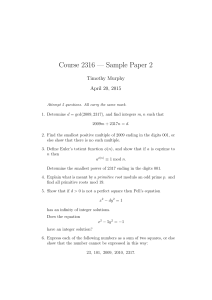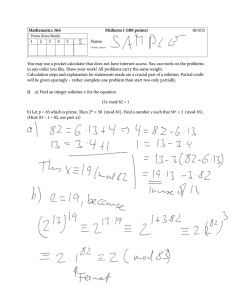Generating large primes
advertisement
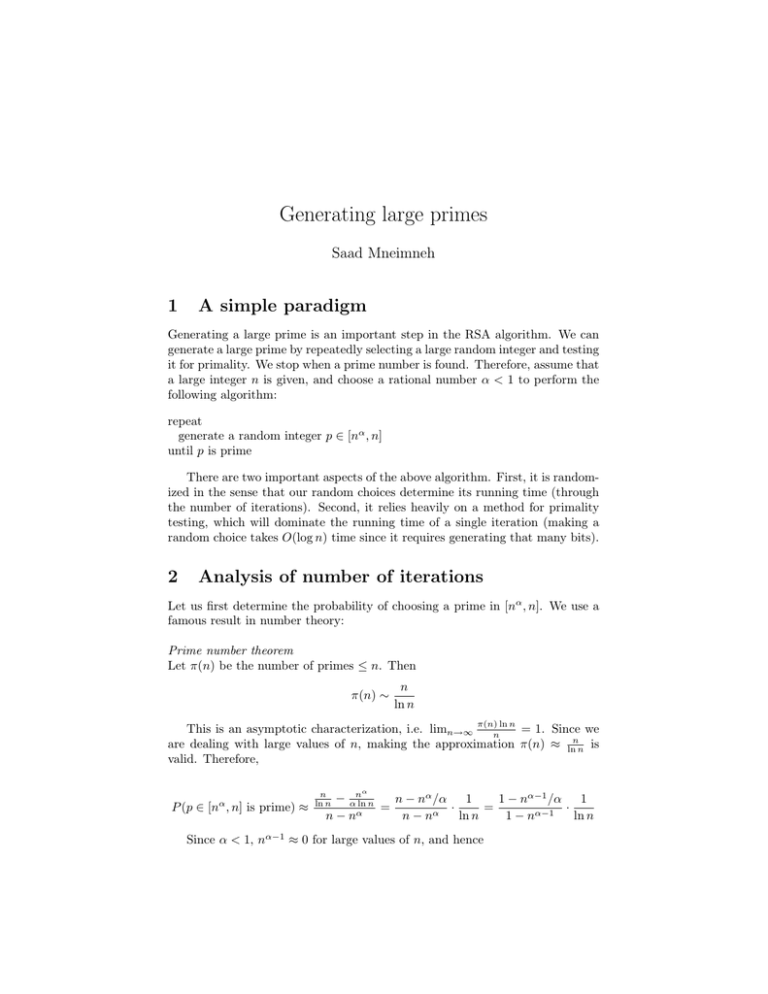
Generating large primes
Saad Mneimneh
1
A simple paradigm
Generating a large prime is an important step in the RSA algorithm. We can
generate a large prime by repeatedly selecting a large random integer and testing
it for primality. We stop when a prime number is found. Therefore, assume that
a large integer n is given, and choose a rational number α < 1 to perform the
following algorithm:
repeat
generate a random integer p ∈ [nα , n]
until p is prime
There are two important aspects of the above algorithm. First, it is randomized in the sense that our random choices determine its running time (through
the number of iterations). Second, it relies heavily on a method for primality
testing, which will dominate the running time of a single iteration (making a
random choice takes O(log n) time since it requires generating that many bits).
2
Analysis of number of iterations
Let us first determine the probability of choosing a prime in [nα , n]. We use a
famous result in number theory:
Prime number theorem
Let π(n) be the number of primes ≤ n. Then
π(n) ∼
n
ln n
This is an asymptotic characterization, i.e. limn→∞ π(n)nln n = 1. Since we
are dealing with large values of n, making the approximation π(n) ≈ lnnn is
valid. Therefore,
P (p ∈ [nα , n] is prime) ≈
n
ln n
α
− αnln n
n − nα /α
1
1 − nα−1 /α
1
=
·
=
·
α
α
n−n
n−n
ln n
1 − nα−1
ln n
Since α < 1, nα−1 ≈ 0 for large values of n, and hence
1
ln n
Let p1 , p2 , . . . , pm be a sequence of randomly generated numbers such that
pm is the first prime. Then m has a geometric distribution and E[m] = ln n.
Therefore, the expected running time in terms of iterations is O(log n). Note
that this is an expected running time, not a deterministic one. Yet, we can show
that the running time is O(f (n) log n) with high probability for every increasing
function f (n). The probability that a prime number is not found in f (n) ln n
trials is
P (p ∈ [nα , n] is prime) ≈
³
1 ´ln n if (n)
1 ´f (n) ln n h³
1−
= 1−
∼ e−f (n) → 0
ln n
ln n
3
Primality testing
Given a positive integer n, we would like to test if it is prime. Here’s a trivial
algorithm for this task based on finding a divisor for n:
for i ← 2 to n
if n ≡ 0 (mod i)
then return false
return true
The running time of this algorithm is O(n) which is exponential in the size
of n (log n bits). A simple improvement
√ can be achieve by observing that if n is
composite, it must have a divisor ≤ n. This is because a composite number is
the product
of two smaller numbers; therefore, n = ab where a ≤ b < n. Hence,
√
a ≤ n.
√
for i ← 2 to b nc
if n ≡ 0 (mod i)
then return false
return true
But the running time is still exponential in the size of n. To obtain a substantial improvement, we rely on another famous result in number theory:
Fermat’s little theorem
If n is prime and 1 ≤ a < n, then an−1 ≡ 1(modn).
Therefore, if for some 1 ≤ a < n, an−1 6≡ 1(modn), then a is a witness for
the compositeness of n. However, if an−1 ≡ 1(modn), Fermat’s little theorem
does not assert the primality of n. For example, 2341−1 ≡ 1( mod 341); however,
341 = 11·31 is not prime. Fermat’s theorem can be strengthened to show that n
is prime if every 1 ≤ a < n satisfies an−1 ≡ 1(modb), but we are not interested
in an algorithm that tests every 1 ≤ a < n for obvious reasons. One idea is to
test few values for a randomly chosen in [1, n − 1].
for i ← 1 to k
choose a random a ∈ [1, n − 1]
if an−1 6≡ 1 (mod n)
then return false
return true
We will appreciate the effectiveness of this test by proving the following
fact: Let 1 ≤ a < n be such that gcd(n, a) = 1 (this also means that a has a
multiplicative inverse modulo n). If an−1 6≡ 1( mod n), then the same is true for
at least (n − 1)/2 values in [1, n − 1]. Let bn−1 ≡ 1(modn), then
(ab)n−1 ≡ an−1 bn−1 ≡ an−1 6≡ 1(modn)
Furthermore, if ab ≡ ac(modn), then b = c (simply multiply each side by
the multiplicative inverse of a). We have just proved that every integer b ∈
[1, n−1] that passes the Fermat test is associated with a unique integer ab mod n
that fails the test. Therefore, at least half the integers in [1, n − 1] fail the test.
The probability of not choosing one of them is 21k which is minuscule if k = 50
or k = 100.
But what if n is composite but an−1 ≡ 1( mod n) for every a ∈ [1, n − 1] that
is relatively prime to n? Such n is called a Carmichael number. Carmichael
numbers are rare, the smallest one is 561 = 3 · 11 · 17. The Fermat test above
can be modified to make at least (n − 1)/2 values in [1, n − 1] fail the test
for Carmichael numbers. This modification is know as the Miller-Rabin algorithm for primality testing. Their idea is to first compute au mod n instead of
an−1 mod n, where n − 1 = 2t u and u is odd. Given au , an−1 is then computed
through the following sequence:
0
1
2
au = a2 u , a2 u , a2 u , . . . , a2
t
u
= an−1
Each term can be obtained by squaring the previous one (all modulo n of
course). This idea is based on the following observation: If n is prime, then
either au ≡ 1 or some term in the above sequence is ≡ −1. Here’s a proof:
x2 ≡ 1(modn) ⇒ x2 − 1 ≡ 0(modn) ⇒ (x − 1)(x + 1) ≡ 0(modn)
Therefore, n divides either (x − 1) or (x + 1). The only way this can happen is
for x ≡ 1(modn) or x ≡ −1(modn). In other words, there is no root of 1 that
is not 1 or −1. Consequently, since an−1 ≡ 1, either au ≡ 1 or some term in the
i
i+1
sequence is ≡ −1. Therefore, if a2 u 6≡ ±1 and a2 ≡ 1, n must be composite.
For example, 561 − 1 = 24 35. For a = 7, a35 ≡ 241(mod561). This will give
the following sequence:
241 298 166 67 1
Therefore, 672 ≡ 1(mod 561), an indication that 561 cannot be prime. Some
number theory (that we omit) tells us that at least (n − 1)/2 values for a ∈
[1, n − 1] must reveal such an instance (a non-primitive root of 1).
Miller-Rabin
let n − 1 = 2t u (u odd)
for i ← 1 to k
choose a random a ∈ [1, n − 1]
x0 ← au mod n
for j ← 1 to t
xj = x2j−1 mod n
if xj = 1 and xj−1 6≡ ±1
then return false
if xt 6= 1
then return false
return true
Since t = O(log n), the running time of this algorithm is dominated by the
computation of au mod n, which at the surface, requires O(n) multiplications.
The next section illustrates how this can be computed in O(log n) time.
4
Repeated squaring
There is a recursive algorithm to compute au using only O(log u) multiplications.
u=0
1
au =
(au/2 )2 u even
a · au−1 u odd
Consider the sequence {u} given by the values of u over the entire execution
of this algorithm:
u0 , u1 , . . . , um = 0
where u0 = u and either ui = ui−1 /2 or ui = ui−1 − 1.
Consider the sequence {b} obtained from {u} by dropping the odd terms:
b0 , b1 , . . . , br = 0
where b0 ≤ u and bi ≤ bi−1 /2, and compare this sequence to the sequence {c}:
c0 = u, c1 = u/2, c2 = u/4, . . . , ck
where 1 ≤ ck < 2. It is trivial to show that bi ≤ ci and, therefore, bk = 0 if it
exists, hence r ≤ k. Since m ≤ 2r + 1, m ≤ 2k + 1.
ck 2k = u ⇒ k = log u − log ck
Therefore, k ≤ blog uc and m ≤ 2blog uc + 1 which shows that the algorithm
requires O(log u) multiplications. However, to be fair we must make sure that
all intermediate numbers do not exceed n; otherwise, multiplications cannot be
considered to be comparable in complexity. This can be achieved by an easy fix
since what we need eventually is au mod n anyway.
u=0
1
au mod n =
(au/2 )2 mod n u even
a · au−1 mod n u odd

